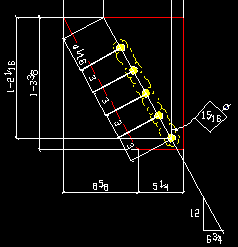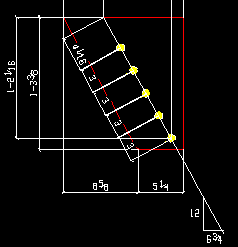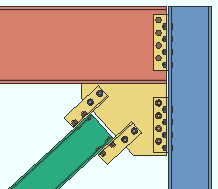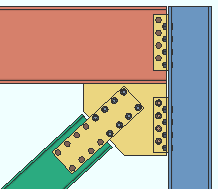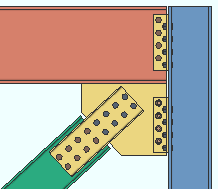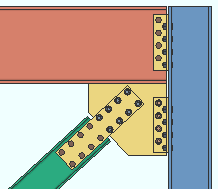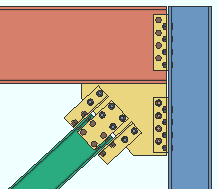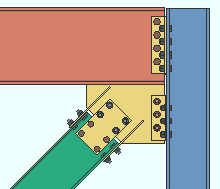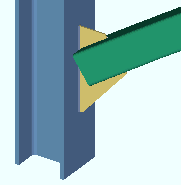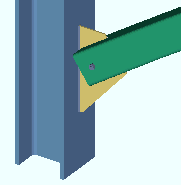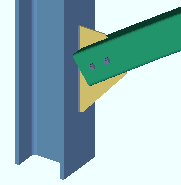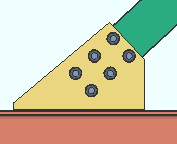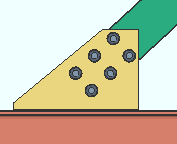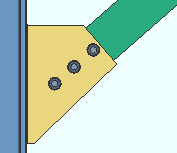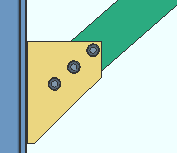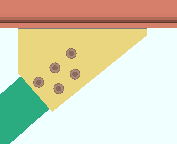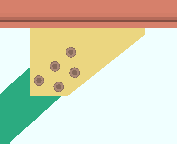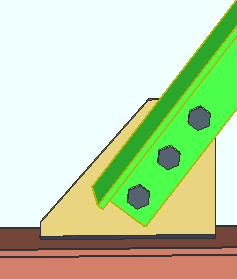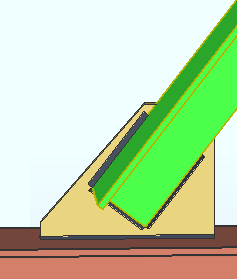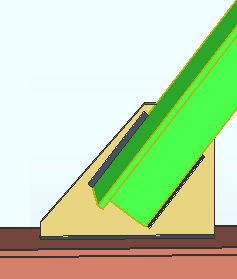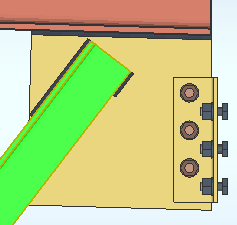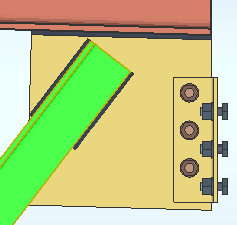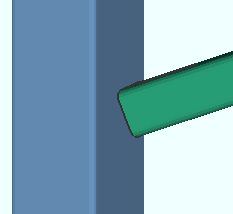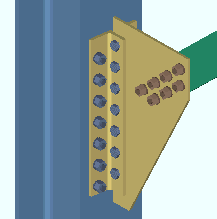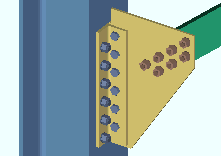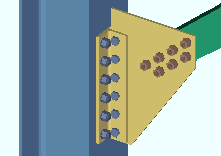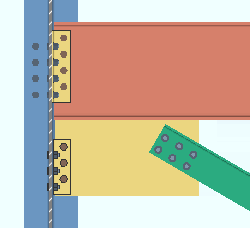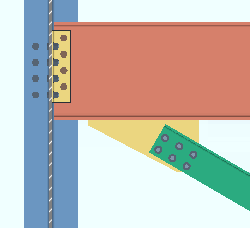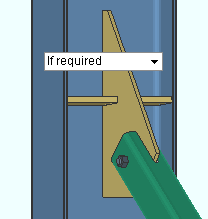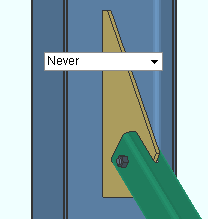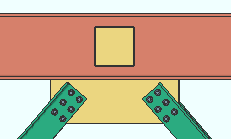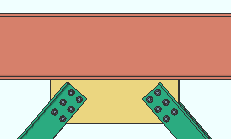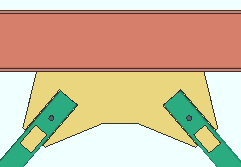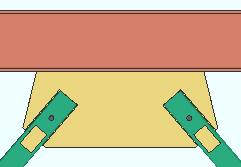'Vbrc plate' connections ("  Connection specifications " and more)
Connection specifications " and more)
On this page :
- Setup of 'Vbrc plate' connections
- 'Vbrc plate' connection specifications:
Also see :
- Connection design locks
- Status Display ( Connection type > Vertical brace )
vertical brace | user defined | top
------ Setup of 'Vbrc plate' connections ------
General setup options :
The Plates setup window sets the default steel grade for vertical brace gusset plates.
Settings under Bracing in Design Settings .
" Design by first incrementing gusset " (' Thickness ' or ' Plate size ') can be found in Plate Design Settings .
The " General settings " in Gusset Plate Settings .
" Brace to other member " in Field Clearances .
" Minimum member end edge distance " in Member Detailing Settings .
If the gusset connects to the supporting member with a clip angle :
Various " Clip angle connection of gusset to supporting member " settings in Member Detailing Settings .
Seismic connections :
" Seismic vertical brace gusset design " in Design Settings .
The " Multiplication factor for the distance between the end of the brace and line of restraint " in Plate Design Settings .
Vertical braces with shared gussets :
" Design for shared gusset if plates are closer than " in Plate Design Settings.
Wide flange vertical braces :
Setup for ' Automatic ' connections is done using the Design Settings options " Wide flange vertical brace gusset web connection " and " Wide flange vertical brace gusset flange connection ."
Home > Project Settings > Fabricator > Standard Fabricator Connections > Preferred Angle Sizes is searched for to find suitable angle sizes when ' Web claw angles ' is selected for " Connection arrangement ."
HSS vertical braces :
" HSS erection bolts " in Member Detailing Settings .
Angle vertical braces :
" Locate angle braces on neutral axis " in Member Detailing Settings .
" Clip end operation on angle brace gusset plates " controls the gusset plate shape.
vertical brace | user defined | top
------ " ![]() Connection specifications " for ' Vbrc plate ' connections ------
Connection specifications " for ' Vbrc plate ' connections ------
|
" |
Gusset plate grade: Auto or user-entered . This " ![]() Connection specifications " option applies to vertical brace intersection plates as well as to gusset plates. The option can be found on the Vertical Brace Review window or at Home > Project Settings > Job > User Defined Connections .
Connection specifications " option applies to vertical brace intersection plates as well as to gusset plates. The option can be found on the Vertical Brace Review window or at Home > Project Settings > Job > User Defined Connections .
In a full-featured SDS2 program . . .
'
Auto (checked) ' specifies that connection design apply a setup choice ( Home > Project Settings > Fabricator > Standard Fabricator Connections > Plates > " Vertical Brc Gussets " section > " Plate material grade ").
'
Auto (not checked) ' lets you select a steel grade on the list box (
). Choices on the list box come from Home > Project Settings > Job > Plate Grades .
Use OS gusset holes: ![]() or
or ![]() . This "
. This " ![]() Connection specifications " option affects holes in the brace-to-gusset interface only. It does not affect holes in, for example, a gusset-to-clip angle interface. The option can be found on the Vertical Brace Review window or at Home > Project Settings > Job > User Defined Connections .
Connection specifications " option affects holes in the brace-to-gusset interface only. It does not affect holes in, for example, a gusset-to-clip angle interface. The option can be found on the Vertical Brace Review window or at Home > Project Settings > Job > User Defined Connections .
|
In a full-featured SDS2 program . . .
If this box is checked (
), connection design uses oversized round holes in the brace-to-gusset interface. Since AISC guidelines require that slip critical bolts be used in such situations, the " NM bolt type " is automatically changed to slip critical bolts -- for example, to ' A325SC ' bolts.
If the box is not checked (
), standard round holes are used for the brace-to-gusset interface.
Connection arrangement: Web claw angles or Flange gussets or Standard connection . This " ![]() Connection specifications " option applies when the " Section size " under this vertical brace's "
Connection specifications " option applies when the " Section size " under this vertical brace's " ![]() General settings " is a flanged shape such as wide flange or S shape or welded plate wide flange. The option can be found on the Vertical Brace Review window or at Home > Project Settings > Job > User Defined Connections .
General settings " is a flanged shape such as wide flange or S shape or welded plate wide flange. The option can be found on the Vertical Brace Review window or at Home > Project Settings > Job > User Defined Connections .
In a full-featured SDS2 program when " Web orientation " is ' Horizontal ' . . .
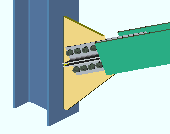
|
' Web claw angles ' instructs connection design to attempt to connect the brace to the gusset with four angles. The gusset welds to the supporting member. To find an angle, connection design searches the list at Home > Project Settings > Fabricator > Standard Fabricator Connections > Preferred Angle Sizes . If it can't find a suitable angle in that list, it searches the local shape file . |
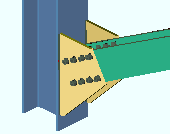
|
' Flange gussets ' configures connection design to try to create two flange gussets that weld to the supporting member and field bolt to the flanges of the brace. If a supporting column's flange is too narrow, welded clip angles may be used to effectively widen the flange of that column. |
In a full-featured SDS2 program when " Web orientation " is ' Vertical ' . . .
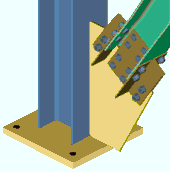
|
' Standard connection ' instructs connection design to connect the brace to the gusset with flange angles and web connection plates. Additional configuration controls: " Web connection type " and " Flange connection type ." |
Web connection type: Automatic or None or Web plates or Channels . This " ![]() Connection specifications " option applies when ' Standard connection ' is selected as the " Connection arrangement " for a wide flange vertical brace whose " Web orientation " is ' Vertical '. The option can be found on the Vertical Brace Review window or at Home > Project Settings > Job > User Defined Connections .
Connection specifications " option applies when ' Standard connection ' is selected as the " Connection arrangement " for a wide flange vertical brace whose " Web orientation " is ' Vertical '. The option can be found on the Vertical Brace Review window or at Home > Project Settings > Job > User Defined Connections .
|
|
|||||||||
| The vertical brace on the left has a smaller section size and a smaller applied tension load than do the braces in the other two examples. |
In a full-featured SDS2 program . . .
' Automatic ' specifies that connection design apply the choice made at Home > Project Settings > Job > Design Settings > " Wide flange vertical brace gusset web connection ."
' None ' can get a connection when the " Flange connection type " is set to ' Flange claw angles '. That connection will consist of flange claw angles without a web connection.
' Web plates ' can get a connection when the " Flange connection type " is set to ' Flange claw angles ' or to ' Flange paddle plates ' or to ' None '. The NS and FS web plates connect the web of the web-vertical wide flange vertical brace to the gusset plate.
' Channels ' can get a connection when the " Flange connection type " is set to ' None '. If " Flange connection type " is set to ' Flange claw angles ', connection design fails the connection and emits the failure massage " Incompatible web and flange connection types ." A channel web connection consists of NS and FS channels that connect the web-vertical wide flange vertical brace to the gusset plate.
Connection failure message: WF brace flg is too narrow for connection
Connection failure message: Incompatible web and flange connection types.
Flange connection type: Automatic or None or Flange claw angles or Flange paddle plates . This " ![]() Connection specifications " option applies when ' Standard connection ' is selected as the " Connection arrangement " for a wide flange vertical brace whose " Web orientation " is ' Vertical '. The option can be found on the Vertical Brace Review window or at Home > Project Settings > Job > User Defined Connections .
Connection specifications " option applies when ' Standard connection ' is selected as the " Connection arrangement " for a wide flange vertical brace whose " Web orientation " is ' Vertical '. The option can be found on the Vertical Brace Review window or at Home > Project Settings > Job > User Defined Connections .
|
|
|||||||||
| The left and middle examples have the same " Tension load ." The example on the right has a smaller " Tension load ." |
|
' Flange paddle plates ' can be designed with or without ' Web plates '. |
In a full-featured SDS2 program . . .
' Automatic ' specifies that connection design apply the choice made to at Home > Project Settings > Job > Design Settings > " Wide flange vertical brace gusset flange connection ."
' None ' instructs connection design to attempt to design a ' Standard connection ' that does not use claw angles. Web plates and channel web connections can potentially be designed without flange angles.
' Flange claw angles ' with the " Web connection type " set to ' Automatic ' configures connection design to attempt to create a ' Standard connection ' that uses claw angles to connect the wide flange vertical brace's flanges to the gusset plate. The shape of the gusset is adjusted to permit the flange angles to fit. Connection design is able to design web plates with flange angles but cannot design a channel web connection with flange angles. Flange angles can be designed without a web connection.
' Flange paddle plates ' with " Web connection type " set to ' Automatic ' specifies that connection design attempt to design a ' Standard connection ' that uses paddle plates to connect the wide flange vertical brace's flanges to the gusset plate. The shape of the gusset is adjusted to permit the flange angles to fit. Connection design is able to design web plates with flange paddle plates but cannot design a channel web connections with flange paddle plates. Flange paddle plates can be designed without a web connection.
Connection failure message: Incompatible web and flange connection types
Connection failure message: WF brace flg is too narrow for connection
Pipe/tube end-fitting: Welded or Bolted or Paddle plate or Paddle plate (double shear) or Double paddle plate. This " ![]() Connection specifications " option applies when -- under "
Connection specifications " option applies when -- under " ![]() General settings " -- the vertical brace's " Section size " is an HSS or pipe or tube. The option can be found on the Vertical Brace Review window or at Home > Project Settings > Job > User Defined Connections .
General settings " -- the vertical brace's " Section size " is an HSS or pipe or tube. The option can be found on the Vertical Brace Review window or at Home > Project Settings > Job > User Defined Connections .
In a full-featured SDS2 program . . .

|
' Welded ' cuts a ' Notch ' in the HSS brace so that it fits around the gusset for field welding. One, two or zero A307 erection field bolts hold the brace into place for field welding. 3D field welds are generated in the model. See : " Notch length clearance " and " Erection bolts ." |
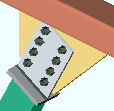
|
' Bolted ' instructs connection design to create a built-up tee (made of plates) that shop welds to the end of the HSS vertical brace so that the brace can be field bolted to the gusset. |
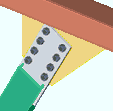
|
' Paddle plate ' configures connection design to ' Notch ' the HSS brace so that the paddle plate can be fitted into the notch and be shop welded to the brace. The paddle plate field bolts to the gusset. |
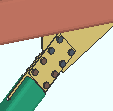
|
' Paddle plate (double shear) ' inserts a paddle plate in the HSS brace. The paddle plate is centered in the notched HSS brace and with respect to the gusset thickness. Connection plates shop bolt to each side of the centered paddle plate and field bolt to both sides of the gusset plate. |
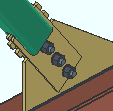
|
' Double paddle plate ' puts paddle plates on both sides of the gusset plate. Spacer plates that are the thickness of the gusset plate are inserted between the paddle plates along the length of the HSS slot. |
'Welded' locks: VBrc to a beam || to a column || to beam & column || shared
'Paddle plate' locks: VBrc to a beam || to a column || to beam & column || shared || to a column & base/cap plate
Setup:
'Bolted' locks: VBrc to a beam || to a column || to beam & column || shared || to a column & base/cap plate
'Paddle (double shear)' locks: VBrc to a beam || to a column || to beam & column || to a column & base/cap plate Total notch width clearance (for ' Welded ' and ' Paddle plate ' and ' Paddle plate (double shear) ')
Setup: HSS double paddle clearance (for ' Double paddle plate ')
Notch length clearance: The distance (in the primary dimension " Units " or other units ) that the notch extends beyond the gusset plate into the interior of the HSS brace. This option applies when -- here in " ![]() Connection specifications " -- the " Pipe/tube end fitting " is ' Welded ' and -- in "
Connection specifications " -- the " Pipe/tube end fitting " is ' Welded ' and -- in " ![]() General settings " -- the " Section size " for this brace is a HSS rectangular (tube) or HSS round (pipe) section. The option can be found on the Vertical Brace Review window or at Home > Project Settings > Job > User Defined Connections .
General settings " -- the " Section size " for this brace is a HSS rectangular (tube) or HSS round (pipe) section. The option can be found on the Vertical Brace Review window or at Home > Project Settings > Job > User Defined Connections .
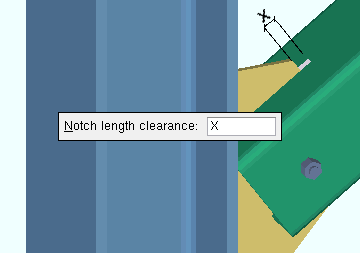
|
| The " Notch length clearance " (X) for a tube vertical brace field welded to the gusset. |
Erection bolts: Automatic or None or One or Two . This applies when -- here in " ![]() Connection specifications " -- the " Pipe/tube end fitting " is ' Welded ' and -- in "
Connection specifications " -- the " Pipe/tube end fitting " is ' Welded ' and -- in " ![]() General settings " -- the " Section size " for this brace is a HSS rectangular (tube) or HSS round (pipe) section. The option can be found on the Vertical Brace Review window or at Home > Project Settings > Job > User Defined Connections .
General settings " -- the " Section size " for this brace is a HSS rectangular (tube) or HSS round (pipe) section. The option can be found on the Vertical Brace Review window or at Home > Project Settings > Job > User Defined Connections .
|
|
|
In a full-featured SDS2 program . . .
' Automatic ' specifies that connection design apply the choice made to Home > Project Settings > Fabricator > Member Detailing Settings > the " Vertical Braces " tab > " HSS erection bolts "
' None ' stops the generation of an erection bolt or the holes that the bolt goes into.
' One ' instructs connection design to create an A307 field erection bolt along with holes for inserting the bolt into.
' Two ' configures connection design to create two A307 field erection bolts along with holes for inserting the bolts into.
Clip end operation: Automatic or Yes or No . This " ![]() Connection specifications " option can apply to a vertical brace whose " Section size " is a W tee (WT), a channel (C or MC), or an angle (L). If the connection is for a " Seismic brace ," the gusset plate will always be clipped, regardless of the choice made here. The option can be found on the Vertical Brace Review window or at Home > Project Settings > Job > User Defined Connections .
Connection specifications " option can apply to a vertical brace whose " Section size " is a W tee (WT), a channel (C or MC), or an angle (L). If the connection is for a " Seismic brace ," the gusset plate will always be clipped, regardless of the choice made here. The option can be found on the Vertical Brace Review window or at Home > Project Settings > Job > User Defined Connections .
|
|||||||
|
|||||||
|
In a full-featured SDS2 program . . .
' Automatic ' specifies that connection design apply the choice made to " Clip end operation on W tee brace gusset plates " or " Clip end operation on channel brace gusset plates " or " Clip end operation on angle brace gusset plates " at Home > Project Settings > Fabricator > Standard Fabricator Connections > Standard Gusset Plate Settings .
' Yes ' instructs connection design to perform a ' Clip ' operation on the gusset plate to create an edge perpendicular to the vertical brace. In the table below, the names of leaves containing connection design locks are listed in the 'Yes' column.
' No ' configures connection design to not perform the ' Clip ' operation, and the gusset comes to a point over the vertical brace. In the table below, the names of leaves containing connection design locks are listed in the 'No" column.
Connection design locks:
|
' Yes '
(WT, C, L) |
' No '
(W tee, channel) |
' No '
(angle) |
|
| to a beam | Gusset One Member | Gusset One Member Square | Gusset One Member Square |
| to a column | Gusset One Member | Gusset One Member Square | Gusset One Member Square |
| to a beam & col | Gusset Beam Column | Gusset Beam Column Square | Gusset Beam Column Square |
| shared gusset | Gusset 2 Point | Gusset 2 Point Square | Gusset 2 Point Square |
| to column & plate | Gusset Column Cap | Gusset Column Cap Square | Gusset Column Cap Square |
Angle end fitting: Bolted or Welded . A vertical brace can be welded to its gusset plate when -- in " ![]() General settings " -- its " Section size " is an angle and " Double material " is either not checked (
General settings " -- its " Section size " is an angle and " Double material " is either not checked ( ![]() ) or checked (
) or checked ( ![]() ). If "
). If " ![]() Double material " is checked, the " Configuration " must be ' Back to back '. This "
Double material " is checked, the " Configuration " must be ' Back to back '. This " ![]() Connection specifications " option can be found on the Vertical Brace Review window or at Home > Project Settings > Job > User Defined Connections .
Connection specifications " option can be found on the Vertical Brace Review window or at Home > Project Settings > Job > User Defined Connections .
|
|
In a full-featured SDS2 program . . .
' Bolted ' bolts the angle(s) to the gusset plate.
' Welded ' welds the angle(s) to the gusset plate. The options " Include end welds " and " Balanced welds " configure the weld pattern.
Include end welds: Automatic or Yes or No . This " ![]() Connection specifications " option applies when " Angle end fitting " is set to ' Welded '. The option can be found on the Vertical Brace Review window or at Home > Project Settings > Job > User Defined Connections .
Connection specifications " option applies when " Angle end fitting " is set to ' Welded '. The option can be found on the Vertical Brace Review window or at Home > Project Settings > Job > User Defined Connections .
|
|
In a full-featured SDS2 program . . .
' Automatic ' applies the choice made to " Welded angle end weld " under the " Vertical Braces " section in Member Detailing Settings ( Fabricator Setup ).
' Yes ' welds three sides of the angle to the gusset plate. One weld is placed on the end of the angle. The other two welds run along the length of the angle.
' No ' welds two sides of the angle to the gusset plate. Both welds are along the length of the angle.
Balanced welds: Automatic or Yes or No . This " ![]() Connection specifications " option applies when " Angle end fitting " is set to ' Welded '. The option can be found on the Vertical Brace Review window or at Home > Project Settings > Job > User Defined Connections .
Connection specifications " option applies when " Angle end fitting " is set to ' Welded '. The option can be found on the Vertical Brace Review window or at Home > Project Settings > Job > User Defined Connections .
|
|
In a full-featured SDS2 program . . .
' Automatic ' applies the choice made to " Welded angle balanced welds " under the " Vertical Braces " section in Member Detailing Settings ( Fabricator Setup ).
' Yes ' instructs the program to attempt to design a weld group that is balanced. A weld group is balanced when its center of resistance aligns with the center of force.
' No ' welds the angle to the gusset using welds of equal length along the length of the brace.
Use HSS column reinforcement plate: Automatic or Yes or No . This " ![]() Connection specifications " option applies when a vertical brace with a gusset plate frames to an HSS rectangular (or tube) column with a thin wall.
Connection specifications " option applies when a vertical brace with a gusset plate frames to an HSS rectangular (or tube) column with a thin wall.
|
|
|
In a full-featured SDS2 program . . .
' Automatic ' specifies that connection design apply the choice made at Home > Project Settings > Job > Plate Design Settings > " Use HSS column reinforcement plate "
' Yes ' instructs connection design to weld a reinforcement plate to the face of the HSS rectangular column if such a reinforcement plate is needed to prevent a connection design failure. The vertical brace gusset plate welds to the reinforcement plate.
' No ' configures connection design to not create an HSS column reinforcement plate. The connection may fail with the message " HSS wall strength fails ."
Plate Design Settings: Use HSS column reinforcement plate ( Home > Project Settings > Job )
End connection failure message: HSS wall strength fails ( Vertical Brace Review window)
Connection design locks: Column Reinf Plate ( Vertical Brace Review window)
Gusset to supporting member: Automatic (uses setup choice) or Welded (shop welded) or Clip angle (' Bolted ' or ' Welded '). This applies in the following framing situations: This " ![]() Connection specifications " option applies in the following framing situations:
Connection specifications " option applies in the following framing situations:
| Welded | Clip angle | |
| Case 1 : vertical brace to beam only |
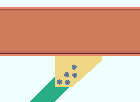
|
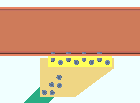
|
| Case 2 : vertical brace to column only |

|

|
| Case 3 : beam on a vbrc to beam & column when a clip angle bolts to the column |
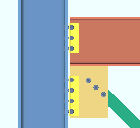
|
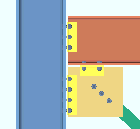
|
| Case 4 : vertical brace to a wide flange vertical brace |

|

|
Gusset to beam clips: Match column clip or From setup/conn spec . This " ![]() Connection specifications " option applies when ' Clip angle ' is selected for " Gusset to supporting member " and the vertical brace frames to a beam and column. In such a case, connection design creates the clip angle using the same angle, hole size, bolt size, spacing, etc. as the clip angle on the beam. The option can be found on the Vertical Brace Review window or at Home > Project Settings > Job > User Defined Connections .
Connection specifications " option applies when ' Clip angle ' is selected for " Gusset to supporting member " and the vertical brace frames to a beam and column. In such a case, connection design creates the clip angle using the same angle, hole size, bolt size, spacing, etc. as the clip angle on the beam. The option can be found on the Vertical Brace Review window or at Home > Project Settings > Job > User Defined Connections .
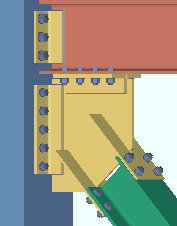
|
A vertical brace to a beam and column. |
In a full-featured SDS2 program . . .
' Match column clip ' instructs connection design to attempt to bolt the gusset to the beam using the same clip angle settings that are applied to the clip angle that bolts the gusset to the column.
' From setup/conn spec ' instructs connection design to attempt use the " Clip angle size " and other settings that are set on this window. If those options are set to ' Auto ', connection design attempts to use the appropriate choices made to Home > Project Settings > Fabricator > Member Detailing Settings > " Vertical Braces " section.
Gusset to clip connection: Automatic or Welded or Bolted . This " ![]() Connection specifications " option sets the method for attaching the clip angle to the gusset plate when ' Clip angle ' is selected for " Gusset to supporting member ." The option can be found on the Vertical Brace Review window or at Home > Project Settings > Job > User Defined Connections .
Connection specifications " option sets the method for attaching the clip angle to the gusset plate when ' Clip angle ' is selected for " Gusset to supporting member ." The option can be found on the Vertical Brace Review window or at Home > Project Settings > Job > User Defined Connections .
|
|
In a full-featured SDS2 program . . .
' Automatic ' specifies that connection design apply the choice made at Home > Project Settings > Job > Member Detailing Settings > the " Vertical Braces " section > " Gusset to clip connection ."
' Welded ' instructs connection design to shop weld the clip angle to the gusset plate.
' Bolted ' configures connection design to, where connection failure can be avoided, shop bolt the clip angle to the gusset plate and leave a half-inch clearance (13 mm) between the gusset and the face of the supporting member. Connection design may change the connection to welded instead of failing the connection.
Clip angle size: ![]() Auto or user-entered . This "
Auto or user-entered . This " ![]() Connection specifications " option sets the angle material to be used for both the near side and far side clip angles.
Connection specifications " option sets the angle material to be used for both the near side and far side clip angles.
In a full-featured SDS2 program . . .
'
Auto ' instructs connection design to apply the Home > Project Settings > Fabricator > Member Detailing Settings > " Vertical Braces " section > " Clip angle size ." Connection design checks the leg, outstanding leg and thickness to see if the angle works. If that angle doesn't work, connection design looks through list in Home > Project Settings > Fabricator > Standard Fabricator Connections > Preferred Angle Sizes for an angle that will work. If one of those angles don't work, connection design looks for an angle in the local shape file . If no angle works, connection design changes the " Gusset to clip connection " to ' Welded '.
'
Auto ' indicates that a user of that full-featured SDS2 program has entered the section size.
Attach long leg to: Automatic or Supported or Supporting . This " ![]() Connection specifications " option can be found on the Vertical Brace Review window or at Home > Project Settings > Job > User Defined Connections .
Connection specifications " option can be found on the Vertical Brace Review window or at Home > Project Settings > Job > User Defined Connections .
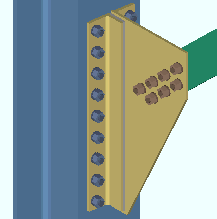
|
In this example, " Attach long leg to " is set to ' Supporting '. The long leg of each of the gusset clip angles bolts to the column. |
In a full-featured SDS2 program . . .
' Automatic ' instructs connection design to apply the choice made to Home > Project Settings > Fabricator > Member Detailing Settings > " Vertical Braces " section > " Attach long leg to ."
' Supported ' fastens the long leg of the clip angle to the gusset plate.
' Supporting ' fastens the long leg of the clip angle to the supporting beam or column or wide flange vertical brace.
Hole type supported: ![]() Auto or Standard round or Short slot or Long slot or Oversized or User slot #1 or User slot #2 . The hole type selected here, together with the "
Auto or Standard round or Short slot or Long slot or Oversized or User slot #1 or User slot #2 . The hole type selected here, together with the " ![]() Connection specifications " option " Bolt diameter ," set the diameter of holes for field bolting the outstanding leg of the angle to the supporting beam, column or wide flange vertical brace.
Connection specifications " option " Bolt diameter ," set the diameter of holes for field bolting the outstanding leg of the angle to the supporting beam, column or wide flange vertical brace.
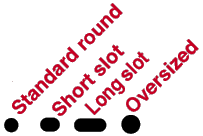
In a full-featured SDS2 program . . .
'
Auto ' ( checked ) instructs connection design to apply a setup choice ( Home > Project Settings > Fabricator > Member Detailing Settings > " Vertical Braces " section > " Hole type supported ").
'
Auto ' ( not checked ) indicates that a user of that full-featured SDS2 program has selected the hole type.
Hole type supporting: ![]() Auto or Standard round or Short slot or Long slot or Oversized or User slot #1 or User slot #2 . The hole type selected here, together with the " Bolt diameter ," set the diameter of holes for shop bolting the outstanding leg of the angle to the supporting beam, column or wide flange vertical brace.
Auto or Standard round or Short slot or Long slot or Oversized or User slot #1 or User slot #2 . The hole type selected here, together with the " Bolt diameter ," set the diameter of holes for shop bolting the outstanding leg of the angle to the supporting beam, column or wide flange vertical brace.

In a full-featured SDS2 program . . .
'
Auto ' ( checked ) instructs connection design to apply a setup choice ( Home > Project Settings > Fabricator > Member Detailing Settings > " Vertical Braces " section > " Hole type supporting ").
'
Auto ' ( not checked ) indicates that a user of that full-featured SDS2 program has selected the hole type.
Bolt type: ![]() Auto or
Auto or ![]() Auto . This "
Auto . This " ![]() Connection specifications " option sets the diameter of bolts in both legs of the clip angle. The bolt diameter entered here, together with the " Hole type supported " or " Hole type supporting ," set the diameter of holes the bolts go into.
Connection specifications " option sets the diameter of bolts in both legs of the clip angle. The bolt diameter entered here, together with the " Hole type supported " or " Hole type supporting ," set the diameter of holes the bolts go into.
In a full-featured SDS2 program . . .
'
Auto ' instructs connection design to apply the choice made to Home > Project Settings > Job > Bolt Settings > " Bolt type " under " Vertical brace gusset to supporting ."
'
Auto ' indicates that a user of that full-featured SDS2 program has selected the bolt type.
Bolt diameter: ![]() Auto or
Auto or ![]() Auto . This sets the diameter of bolts in both legs of the clip angle. The bolt diameter entered here, together with the " Hole type supported " or " Hole type supporting ," set the diameter of holes the bolts go into.
Auto . This sets the diameter of bolts in both legs of the clip angle. The bolt diameter entered here, together with the " Hole type supported " or " Hole type supporting ," set the diameter of holes the bolts go into.
| diameter |
|
In a full-featured SDS2 program . . .
'
Auto ' ( checked ) instructs connection design to apply a setup choice ( Home > Project Settings > Job > Bolt Settings > " Bolt diameter " [for vertical brace to supporting]).
'
Auto ' ( not checked ) indicates that a user of that full-featured SDS2 program has entered the bolt diameter.
Setup options tied to bolt diameter: " Vertical edge distance at ends " ( Clip Angle Settings ), " Allow reduced edge distance for 7/8" and 1" bolts " ( Member Detailing Settings ).
Stagger bolts: Automatic or Yes or No . This " ![]() Connection specifications " option applies to the selected " Clip angle size " as long as the " Gage on supporting member " and " Gage on supported member " are also applied. Also, the " Gusset to clip connection " must be ' Bolted ' (or ' Automatic ' with bolted as the setup choice). The " Stagger bolts " option can be found on the Vertical Brace Review window or at Home > Project Settings > Job > User Defined Connections .
Connection specifications " option applies to the selected " Clip angle size " as long as the " Gage on supporting member " and " Gage on supported member " are also applied. Also, the " Gusset to clip connection " must be ' Bolted ' (or ' Automatic ' with bolted as the setup choice). The " Stagger bolts " option can be found on the Vertical Brace Review window or at Home > Project Settings > Job > User Defined Connections .
|
|
In a full-featured SDS2 program . . .
' Automatic ' specifies that connection design apply the choice made to Home > Project Settings > Fabricator > Detailing > Member Detailing Settings > " Vertical Braces " section > " Stagger bolts ."
' Yes ' instructs connection design to stagger the bolts in the clip angle.
' No ' configures connection design to not stagger the bolts.
Gage on supporting: ![]() Auto or
Auto or ![]() Auto . This "
Auto . This " ![]() Connection specifications " option sets the center-to-center dimension between columns of holes on the outstanding legs of the clip angles. Connection design attempts to apply this gage even if it uses a different " Clip angle size " than that which is selected above.
Connection specifications " option sets the center-to-center dimension between columns of holes on the outstanding legs of the clip angles. Connection design attempts to apply this gage even if it uses a different " Clip angle size " than that which is selected above.
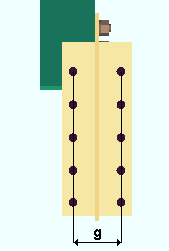
|
g = gage on supporting member. The supporting member in this example is a column (not shown). Connection design uses double clip angles for vertical braces to the supporting member. This does not apply to the clip angle to the column for a vertical brace to a beam and column. |
In a full-featured SDS2 program . . .
'
Auto (checked) ' specifies that connection design use a setup choice ( Home > Project Settings > Fabricator > Member Detailing Settings > " Vertical Braces " section > " Gage on supporting member ").
'
Auto (not checked) ' lets you type in the center-to-center dimension (in the primary dimension " Units " or other units ).
If the gage entered here doesn't work -- for example, because ' 0 ' is entered -- connection design uses the gage in the local shape file for the supporting member (e.g. " Flange gage " for a wide flange column). If that gage doesn't work, connection design uses the angle gage .
UFM special case design: Automatic or No special case or Special case 2 or Special case 3 . This " ![]() Connection specifications " option can be found on the Vertical Brace Review window or at Home > Project Settings > Job > User Defined Connections .
Connection specifications " option can be found on the Vertical Brace Review window or at Home > Project Settings > Job > User Defined Connections .
|
|
|
|
In a full-featured SDS2 program . . .
' Automatic ' specifies that connection design apply the choice made at Home > Project Settings > Job > Design Settings > " UFM special case design ."
' No special case ' instructs connection design to distribute the brace's vertical force to the beam as well as to the gusset-to-column connection. This minimizes the size of the gusset plate, but may result in the beam connection failing under heavily loaded conditions. See The Uniform Force Method , AISC 14th Edition , p 13-3.
' Special case 2 ' instructs connection design to distribute the brace's vertical force to the gusset-to-column connection instead of to the beam. As a result, the beam's vertical reaction is not increased. This may prevent the beam connection from failing if the beam is highly loaded, but also may add rows to the column connection and thus cause the gusset plate to be larger. See Special Case 2, Minimizing Shear in the Beam-to-Column Connection , AISC 14th Edition , p 13-7. The " Case 2 transfer percent " option (below) lets a user of that full-featured SDS2 program specify the percentage of the brace's vertical force to be distributed to the gusset-to-column connection.
' Special case 3 ' configures connection design to connect the vertical brace to the beam, but not to the column. See Special Case 3, No Gusset-to-Column Web Connection , AISC 14th Edition , p 13-7. Be aware that special case 3 does not apply to gusset-to-column flange connections. For gusset-to-column flange connections, the connection is designed as if ' No special case ' has been selected.
Case 2 transfer percent: ' ![]() Auto ' or '
Auto ' or ' ![]() Auto ' . This "
Auto ' . This " ![]() Connection specifications " option applies when ' Special case 2 ' is selected for " UFM special case design ."
Connection specifications " option applies when ' Special case 2 ' is selected for " UFM special case design ."
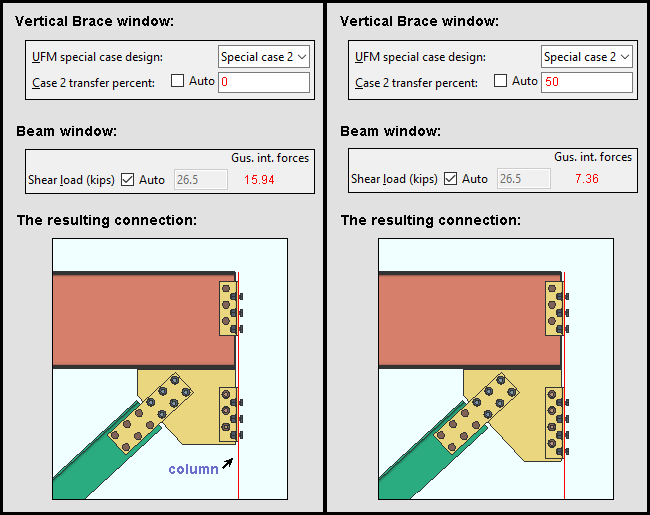
In a full-featured SDS2 program . . .
'
Auto (checked) ' transfers 100% of the gusset interface " Shear " force to the gusset-to-column connection.
'
Auto (not checked)' lets you enter the percentage of vertical gusset interface forces that you want to be transferred from the beam to the gusset-to-column connection. An entry of ' 100 ' percent would result in an entry of 0.0 to " Gusset Interface Forces " in the " Shear " row on the Beam Edit window since the entire shear component of the forces from the brace would be transferred to the gusset-to-column interface. An entry of ' 50 ' percent would result in half of the force being transferred to the gusset-column connection. An entry of ' 0 ' percent would result in all gusset interface forces from the brace being applied to the beam, thus giving you the same result as you would get by choosing ' No special case ' for " UFM special case design ."
Check supporting member for web stress: If required or Never . The " Supporting member web stress " is reported as a " ![]() Left/Right end limit state " when a vertical brace gusset (single, 2 point or 3 point) is welded to the web of the supporting column or beam. This "
Left/Right end limit state " when a vertical brace gusset (single, 2 point or 3 point) is welded to the web of the supporting column or beam. This " ![]() Connection specifications " option controls whether or not web stress is checked by connection design when it designs a gusset plate. The option can be found on the Vertical Brace Review window or at Home > Project Settings > Job > User Defined Connections .
Connection specifications " option controls whether or not web stress is checked by connection design when it designs a gusset plate. The option can be found on the Vertical Brace Review window or at Home > Project Settings > Job > User Defined Connections .
|
||
| Connection design in a full-featured SDS2 program may add a web stiffener when ' If required ' is selected. For 2-point or 3-point gusset plates, two stiffeners may be added. |
|
Design calculation 175 applies when a single vertical brace gusset plate is welded to the web of the supporting column or beam. |
|
Design calculation 359 applies when a 2 point or 3 point vertical brace gusset plate is welded to the web of the supporting column or beam. |
In a full-featured SDS2 program . . .
' If required ' results in design calculations 175 or 359 being a potential cause of connection failure. To prevent such a failure, web stiffeners may be designed with lockable settings shown in the "
Stiffener Plate " leaf. The " Maximum web stiffener thickness " for these stiffeners can be set in Home > Project Settings > Fabricator > Detailing > Member Detailing Settings > the " Vertical Braces " section. The stiffeners can be designed for 2-point, 3-point or single vertical brace gusset plates.
' Never ' results in calculations 175 or 359 still being performed, where applicable, but not ever causing the connection to fail. In the Connection Design Calculations or Expanded Connection Design Calculations , the results of the check is reported with a parenthetical, for-information-only note such as " (For information only, brace force that produces local column web stress of .9Fy (175) 33.0 kips ) "
Connection failure message: Supporting web/flg overstressed by axial load .
Check supporting member for web crippling: If required or For supporting column or For supporting beam or never . This " ![]() Connection specifications " option can be found on the Vertical Brace Review window or at Home > Project Settings > Job > User Defined Connections .
Connection specifications " option can be found on the Vertical Brace Review window or at Home > Project Settings > Job > User Defined Connections .
|
Connection design calculation 361 applies when a vertical brace gusset frames to a beam or column web. |
In a full-featured SDS2 program . . .
' If required ' results in design calculations 361 being a potential cause of connection failure when applicable.
' For supporting column ' results in calculation 361 being a potential causes of connection failure for the supporting column.
' For supporting beam ' results in calculation 361 being a potential causes of connection failure for the supporting beam.
' Never ' results in load calculations 361 still being performed, where applicable, but not ever resulting in a connection design failure. In the Connection Design Calculations or Expanded Connection Design Calculations , the results of the check are reported with a parenthetical, for-information-only note.
Check supporting member for web shear: This " ![]() Connection specifications " option applies to 2-point vertical braces to a beam or column. The option can be found on the Vertical Brace Review window or at Home > Project Settings > Job > User Defined Connections . The option has no effect on a " Seismic brace " since the supporting beam or column for 2-point seismic braces is always checked for web shear, regardless of the choice made here.
Connection specifications " option applies to 2-point vertical braces to a beam or column. The option can be found on the Vertical Brace Review window or at Home > Project Settings > Job > User Defined Connections . The option has no effect on a " Seismic brace " since the supporting beam or column for 2-point seismic braces is always checked for web shear, regardless of the choice made here.
|
||
| Connection design may add beam web doublers for a 2-point vertical brace when ' If required ' is selected. |
|
This example was taken from the Expanded Connection Design Calculations report on brace in a 2-point vertical brace connection. |
In a full-featured SDS2 program . . .
' If required ' results in design calculations 442 potentially creating web doublers to strengthen the supporting member's web. That supporting member can be a beam or a column. Connection design locks are maintained in a leaf named "
Web Doublers " that can be found on the Vertical Brace window. By default, the doublers are placed on both sides of the beam's or column's web, but this can be changed by adjusting the " Plate location " in the leaf.
' Never ' results in load calculation 442 not being used to check for web shear.
Check supporting member for flange bending: If required or For supporting column or For supporting beam or never . " Beam flange bending " and/or " Column flange bending " are reported as a " ![]() Left/Right end limit state " for a web-horizontal wide flange vertical brace to a beam and column. This "
Left/Right end limit state " for a web-horizontal wide flange vertical brace to a beam and column. This " ![]() Connection specifications " option affects whether or not that limit state is incorporated as a check within connection design that can potentially cause the vertical brace connection to fail.
Connection specifications " option affects whether or not that limit state is incorporated as a check within connection design that can potentially cause the vertical brace connection to fail.
|
Connection design calculation 250 applies when this brace's " Section size " is a wide flange whose " Web orientation " is set to ' Horizontal ' and the brace frames to a beam & column. |
In a full-featured SDS2 program . . .
' If required ' results in design calculations 250 being a potential cause of connection failure when applicable.
' For supporting column ' results in calculation 250 being a potential causes of connection failure for the supporting column.
' For supporting beam ' results in calculation 250 being a potential causes of connection failure for the supporting beam.
' Never ' results in load calculations 250 still being performed, where applicable, but not ever resulting in a connection design failure. In the Connection Design Calculations or Expanded Connection Design Calculations , the results of the check are reported with a parenthetical, for-information-only note such as " For information only --- Beam flange local bending (250) 1053.8 kips ."
AISC seismic 1st ed. 2pt gussets : Automatic or Yes or No . This " ![]() Connection specifications " option applies to the design of 2-point vertical brace gusset plates when " Seismic brace " is set to ' Yes ' (or to ' Automatic ' with "
Connection specifications " option applies to the design of 2-point vertical brace gusset plates when " Seismic brace " is set to ' Yes ' (or to ' Automatic ' with " ![]() Seismic vertical brace gusset design " checked on). The option can be found on the Vertical Brace Review window or at Home > Project Settings > Job > User Defined Connections .
Seismic vertical brace gusset design " checked on). The option can be found on the Vertical Brace Review window or at Home > Project Settings > Job > User Defined Connections .
|
|
||
| The 1st edition AISC seismic design manual specifies more cuts for 2-point gusset plates than does later editions of that same manual. |
In a full-featured SDS2 program . . .
' Automatic ' specifies that connection design apply the choice made at Home > Project Settings > Job > Design Settings > " Use AISC seismic design 1st edition for 2 point gusset design ."
' Yes ' instructs connection design to create a 2-point seismic gusset plate based on the 1st edition of the AISC seismic design manual. Additional locks for adding stiffeners are provided in " Gusset 2 Point " (HSS) or etc.
' No ' configures connection design to create a 2-point seismic gusset plate based on the 2nd edition of the AISC seismic design manual.
